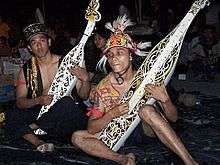Orang Ulu
Orang Ulu (which means "people of the interior) is an ethnic designation politically coined to group together roughly 27 very small but ethnically diverse tribal groups in northeastern Sarawak, Malaysia[1] with populations ranging from less than 300 persons to over 25,000 persons. Orang Ulu is not a legal term and no such racial group exist or listed in the Malaysian Constitution. The term was popularised by a minority association known as "Orang Ulu National Association" (OUNA) that was formed in 1969.
The Orang Ulu typically live in longhouses elaborately decorated with murals and woodcarvings.[2] They are also well known for their intricate beadwork detailed tattoos and rattan weaving.[3] The Orang Ulu tribes can also be identified by their unique music - distinctive sounds from their sapes, a plucked boat-shaped lute, formerly with two strings, nowadays usually with four strings.[4] They also practice Kanjet, a form of traditional dance.[5]
A vast majority of the Orang Ulu tribes are Christians but old traditional religions are still practiced in some areas.
Orang Ulu classification
There are about 27 small Dayak people groups that are classified as Orang Ulu such as:-
- Apo Kayan people
- Bidayuh[1]
- Bisaya (Borneo)[1]
- Murut people[1]
- Tagol[7]
- Punan[1]
- Lisum[7]
- Apo Duat
See also
References
- 1 2 3 4 5 6 7 8 9 "Orang Ulu of Sarawak". Internet FAQ Archives. Retrieved 2016-08-03.
- ↑ Jeffrey Jalong (2001). Kalong: Seni Motif Tradisi Orang Ulu. Kementerian Kebudayaan Kesenian dan Pelancongan Malaysia. ISBN 967-903-035-0.
- 1 2 Patricia Hului (2016-05-25). "Dying Tradition of Orang Ulu Rattan Weaving". The Borneo Post. Retrieved 2016-08-03.
- ↑ Jeffrey Jalong (2007). Sape: Seni Muzik Terbilang Orang Ulu Sarawak.
- ↑ Jeffrey Jalong (2012). Kanjet: Seni Tarian Tradisional Orang Ulu Sarawak. Jabatan Kebudayaan dan Kesenian Negara. ISBN 967-5552-22-0.
- 1 2 3 Erivina. "Our People - Orang Ulu". Sarawak Tourism. Retrieved 2016-08-03.
- 1 2 3 4 5 6 7 Wendy Hutton (2000). Adventure Guides: East Malaysia. Tuttle Publishing. p. 130. ISBN 962-593-180-5.
- 1 2 3 Nizam GTZ. "ORANG ULU". The Patriots. Retrieved 2016-08-03.
- ↑ Frans Welman (2011). Borneo Trilogy Sarawak: Volume 2. Booksmango. p. 138. ISBN 616-245-089-9.
